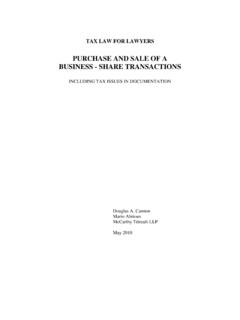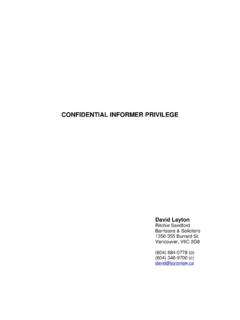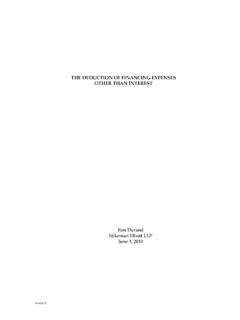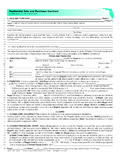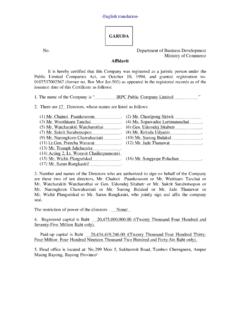Transcription of SHARE CAPITAL DESIGN - Canadian Bar Association
1 SHARE CAPITAL DESIGN PRICE ADJUSTMENT CLAUSES May 29, 2010 June 4, 2010 PRICE ADJUSTMENT CLAUSES* CONSIDERATION RECEIVED FOR TRANSFERRED PROPERTY I. RELEVANT STATUTORY PROVISIONS The Income Tax Act (Canada)1 contains a number of rules that are designed to ensure that transactions between non-arm s-length parties occur at fair market Paragraph 69(1)(a), for example, provides that where a taxpayer has acquired anything from a person with whom the taxpayer does not deal at arm s length for an amount in excess of its fair market value, the taxpayer will be deemed to have acquired the item in question at its fair market value. As a result, to the extent that the purchase price paid by the taxpayer exceeds fair market value, the taxpayer will receive no cost base recognition for such excess.
2 The non-arm s-length transferor, however, will not be entitled to claim a corresponding deduction in calculating its income for tax purposes and, accordingly, will be taxed on the actual proceeds received. Similarly, paragraph 69(1)(b) provides that where a taxpayer has disposed of anything to a non-arm s-length person for no proceeds or for proceeds that are less than fair market value, the taxpayer will be deemed to have received fair market value proceeds. As in the case of paragraph 69(1)(a), the rule in paragraph 69(1)(b) is a one-sided adjustment in favour of the Canada Revenue Agency (the CRA ) because it results in increased income to the transferor without any corresponding increase in cost base for the non-arm s-length , 4 * By Evelyn (Evy) Moskowitz of Moskowitz & Meredith LLP, an affiliate of KPMG LLP.
3 1 RSC 1985, , (5th Supp.), as amended. Unless otherwise stated, all statutory references in this paper are to the Act. 2 Parties will be considered to be dealing at non-arm s length if they are related or do not, in fact, deal with one another at arm s length (section 251). 3 The rule in paragraph 69(1)(b) also applies where a taxpayer disposes of anything to any person (whether or not arm s length) by way of gift inter vivos. In such circumstances, however, the donee does get fair market value cost base recognition for the gifted item. 4 See, however, Interpretation Bulletin IT-405, Inadequate Consideration - Acquisitions and Dispositions, January 23, 1978, paragraph 5, in which the CRA takes the position that it may permit an adjustment to proceeds of disposition or purchase price where paragraph 69(1)(a) or 69(1)(b), respectively, applies if it can be shown - 2 - Even in those circumstances in which subsection 69(1) does not apply, one must be concerned where non-arm s-length parties are involved.
4 For example, the rollover provisions in the Act allow for transfers between non-arm s-length parties at amounts that are less than fair market However, many of these rollover provisions will deny all or part of the rollover where the fair market value of the property transferred exceeds the consideration received by the transferor and it is reasonable to regard any part of such excess as a benefit that the transferor desires to confer on a related The issue of fair market value consideration also arises in the context of other conferral of benefit provisions found in the Act (such as subsection 15(1) which deals with shareholder benefits)7 as well as in those transactions involving CAPITAL gain crystallizations for qualified farm property or shares of a qualified small business II.
5 PRICE ADJUSTMENT CLAUSES To avoid the punitive impact of the foregoing provisions, it is typical, in non-arm s-length transactions involving the transfer of property to a corporation in exchange for shares of that corporation, to include a price adjustment clause that will adjust the value of such SHARE consideration if it is ultimately determined that the property had a value, at the time of transfer, that was greater or less than the value originally ascribed thereto. This adjustment is made retroactive to the date when the shares were issued so that it can be said that, at the time the transfer occurred (which is the relevant time for purposes of the foregoing provisions), the that the transfer occurred at an amount other than fair market value by reason of an honest error and not as a result of a deliberate attempt to evade or avoid tax.
6 5 Subsection 69(1) applies except as otherwise expressly provided for in the Act and these rollover provisions do so otherwise provide. 6 See, for example, paragraph 85(1)( ) and subsections 86(2), 51(2) and 87(4). 7 See, as well, subsections 56(2) and 246(1). 8 The concern in these crystallization situations arises because if, in the course of such a crystallization, the farm property or shares are acquired by a corporation or a partnership for consideration that is less than the fair market value of the property so acquired, paragraph (7)(b) will deny the CAPITAL gains exemption with respect to any CAPITAL gain realized on the crystallization. - 3 - requisite fair market value consideration was received by the transferor. A typical price adjustment clause will also include an adjustment to any other amounts that may be affected by the adjustment to SHARE value such as dividends that have been paid by reference to the value of the shares , as determined prior to the adjustment.
7 A. The CRA s Position The CRA s position with respect to price adjustment clauses is set out in Interpretation Bulletin IT-1699 which clarifies some of the uncertainties that arose as a result of the decision of the Federal Court of Appeal in Guilder News Company (1963) Limited et al. v. In Guilder, the court held that a price adjustment clause in respect of assets transferred by certain corporations to their shareholders was ineffective and the shareholders were therefore deemed to have received a shareholder s benefit. The basis for the court s decision was that the parties did not really attempt to determine the fair market value of the assets transferred such that their expressed intention to sell at fair market value was not genuine.
8 The Guilder case raised concerns that the use of price adjustment clauses would no longer be permitted. Accordingly, Interpretation Bulletin IT-169 was introduced and, in it, the CRA stated that it would recognize a price adjustment clause if all of the following conditions were met: 1. the agreement reflects a bona fide intention of the parties to transfer the property at fair market value and arrives at that value for the purposes of the agreement by a fair and reasonable method;11 2. each of the parties to the agreement notifies the CRA by a letter attached to such party s return for the year in which the property was transferred that: (a) such party is prepared to have the price in the agreement reviewed by the CCA 9 Dated August 16, 1974.
9 10 73 DTC 5048. 11 See CRA Views 2008-0285251C6; Transfers and Loans to Corporations, for CRA s views as to how to determine a fair and reasonable method . - 4 - pursuant to the price adjustment clause; (b) such party will take the necessary steps to settle any resulting excess or shortfall in the price; and (c) a copy of the agreement will be filed with the CRA if and when demanded; and 3. the excess or shortfall in price is actually refunded or paid, or a legal liability therefor is adjusted. The foregoing requirement that the CRA be notified of any price adjustment clause has been viewed by most practitioners as having no basis at law. Thus, general practice has been to ignore this requirement even though the CRA has in the past insisted that it be complied with before the CRA would consider a price adjustment clause to be In recent years, however, the CRA has reversed its position in this regard and has stated that a failure to notify the CRA of a price adjustment clause will not in and of itself preclude the application of Interpretation Bulletin IT-169 if the other conditions set out in the bulletin are Where a price adjustment clause applies to a transfer in respect of which a subsection 85(1)
10 Election has been filed, the CRA used to take the position that an amended election form must be filed under subsection 85( ).14 This position, however, has now been 12 See, for example, Revenue Canada Round Table, in Report of Proceedings of the Thirty-Second Tax Conference, 1980 Conference Report (Toronto: Canadian Tax Foundation, 1981), 591-628, question 14. 13 Revenue Canada Round Table, in Report of Proceedings of the Forty-Second Tax Conference, 1990 Conference Report (Toronto: Canadian Tax Foundation, 1991), 50:1-68, question 58. 14 Information Circular IC 76-19R3, Transfer of Property to a Corporation under Section 85, June 17, 1996, paragraph 26.
